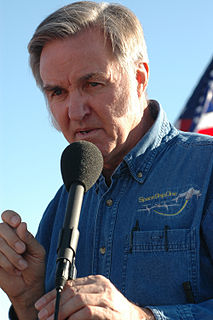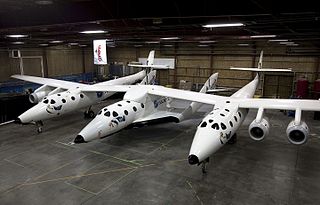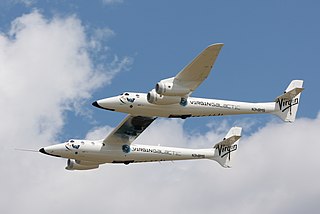
Scaled Composites is an American aerospace company founded by Burt Rutan and currently owned by Northrop Grumman. It is located at the Mojave Air and Space Port in Mojave, California, United States. Founded to develop experimental aircraft, the company now focuses on designing and developing concept craft and prototype fabrication processes for aircraft and other vehicles. It is known for unconventional designs, for its use of non-metal, composite materials, and for winning the Ansari X Prize with its experimental spacecraft SpaceShipOne.

The Ansari X Prize was a space competition in which the X Prize Foundation offered a US$10,000,000 prize for the first non-government organization to launch a reusable crewed spacecraft into space twice within two weeks. It was modeled after early 20th-century aviation prizes, and aimed to spur development of low-cost spaceflight.

SpaceShipOne is an experimental air-launched rocket-powered aircraft with sub-orbital spaceflight capability at speeds of up to 3,000 ft/s (900 m/s), using a hybrid rocket motor. The design features a unique "feathering" atmospheric reentry system where the rear half of the wing and the twin tail booms folds 70 degrees upward along a hinge running the length of the wing; this increases drag while retaining stability. SpaceShipOne completed the first crewed private spaceflight in 2004. That same year, it won the US$10 million Ansari X Prize and was immediately retired from active service. Its mother ship was named "White Knight". Both craft were developed and flown by Mojave Aerospace Ventures, which was a joint venture between Paul Allen and Scaled Composites, Burt Rutan's aviation company. Allen provided the funding of approximately US$25 million.

Elbert Leander "Burt" Rutan is a retired American aerospace engineer and entrepreneur noted for his originality in designing light, strong, unusual-looking, and energy-efficient air and space craft. He designed the record-breaking Voyager, which in 1986 was the first plane to fly around the world without stopping or refueling, and the Virgin Atlantic GlobalFlyer, which in 2006 set the world record for the fastest and longest nonstop non-refueled circumnavigation flight in history. In 2004, Rutan's sub-orbital spaceplane design SpaceShipOne became the first privately funded spacecraft to enter the realm of space, winning the Ansari X-Prize that year for achieving the feat twice within a two-week period.

The Mojave Air and Space Port at Rutan Field is in Mojave, California, United States, at an elevation of 2,801 feet (854 m). It is the first facility to be licensed in the United States for horizontal launches of reusable spacecraft, being certified as a spaceport by the Federal Aviation Administration on June 17, 2004. The facility covers 2,998 acres and has three runways.

Tier One was a Scaled Composites' 1990s–2004 program of suborbital human spaceflight using the reusable spacecraft SpaceShipOne and its launcher White Knight. The craft was designed by Burt Rutan, and the project was funded 20 million US Dollars by Paul Allen. In 2004 it made the first privately funded human spaceflight and won the 10 million US Dollars Ansari X Prize for the first non-governmental reusable manned spacecraft.

Flight 17P of SpaceShipOne was a spaceflight in the Tier One program that took place on October 4, 2004. It was the second competitive flight in the Ansari X Prize competition to demonstrate a non-governmental reusable crewed spacecraft, and is hence also referred to as the X2 flight. It was a successful flight, winning the X PRIZE.

Virgin Galactic is an American spaceflight company founded by Richard Branson and his British Virgin Group retains an 11.9% stake through Virgin Investments Limited. It is headquartered in California, USA, and operates from New Mexico. The company is developing commercial spacecraft and aims to provide suborbital spaceflights to space tourists. Virgin Galactic's suborbital spacecraft are air launched from beneath a carrier airplane known as White Knight Two. Virgin Galactic‘s maiden spaceflight occurred in 2018 with its VSS Unity spaceship. Branson had originally hoped to see a maiden spaceflight by 2010, but the date was delayed for several years, primarily due to the October 2014 crash of VSS Enterprise.

Air launching is the practice of releasing a rocket, missile, parasite aircraft or other aircraft payload from a mother ship or launch aircraft. The payload craft or missile is often tucked under the wing of the larger mother ship and then "dropped" while in flight. It may also be stored within a bomb bay, beneath the main fuselage or even on the back of the carrier aircraft, as in the case of the D-21 drone. Air launching provides several advantages over ground launching, giving the smaller craft an altitude and range boost, while saving it the weight of the fuel and equipment needed to take off on its own.

VSS Enterprise was the first SpaceShipTwo (SS2) spaceplane, built by Scaled Composites for Virgin Galactic. As of 2004, it was planned to be the first of five commercial suborbital SS2 spacecraft planned by Virgin Galactic. It was also the first ship of the Scaled Composites Model 339 SpaceShipTwo class, based on upscaling the design of record-breaking SpaceShipOne.

The Scaled Composites Model 339 SpaceShipTwo (SS2) is an air-launched suborbital spaceplane type designed for space tourism. It is manufactured by The Spaceship Company, a California-based company owned by Virgin Galactic.

The Scaled Composites Model 348 White Knight Two (WK2) is a quadjet cargo aircraft that is used to lift the SpaceShipTwo spacecraft to release altitude. It was developed by Scaled Composites from 2007 to 2010 as the first stage of Tier 1b, a two-stage to suborbital-space crewed launch system. WK2 is based on the successful mothership to SpaceShipOne, White Knight, which itself is based on Proteus.

The Spaceship Company (TSC) is a British/American spacecraft manufacturing company that was founded by Burt Rutan and Richard Branson in mid-2005 and was jointly owned by Virgin Group (70%) and Scaled Composites (30%) until 2012 when Virgin Galactic became the sole owner. TSC was formed to own the technology created by Scaled for Virgin Galactic's Virgin SpaceShip program. This includes developments on the care-free reentry system and cantilevered-hybrid rocket motor, licensed from Paul Allen and Burt Rutan's Mojave Aerospace. The company is manufacturing Virgin Galactic's spacecraft and will sell spacecraft to other buyers. The suborbital launch system offered will include the SpaceShipTwo spacecraft and the White Knight Two carrier aircraft.
SpaceShip III is an upcoming class of spaceplanes by Virgin Galactic to follow SpaceShipTwo. It was first teased on the Virgin Galactic Twitter account on 25 February 2021 announcing the rollout of first plane on 30 March 2021.

Stratolaunch LLC is an American aerospace company providing high-speed flight test services. It was originally formed in 2011 to develop a new air-launched space transportation system, with its corporate headquarters located in Seattle, Washington. The company and development project were officially announced in December 2011 by Microsoft co-founder Paul Allen and Scaled Composites founder Burt Rutan, who had previously collaborated on the creation of SpaceShipOne.

The VSS Enterprise crash occurred on October 31, 2014, when the VSS Enterprise, a SpaceShipTwo experimental spaceflight test vehicle operated by Virgin Galactic, suffered a catastrophic in-flight breakup during a test flight and crashed in the Mojave Desert near Cantil, California. Co-pilot Michael Alsbury was killed and pilot Peter Siebold was seriously injured.

The billionaire space race is the rivalry among entrepreneurs who have entered the space industry from other industries - particularly computing. This private industry space race of the 21st century involves sending rockets to the ionosphere, orbital launch rockets, and suborbital tourist spaceflights.

How to Make a Spaceship: A Band of Renegades, An Epic Race, And the Birth of Private Spaceflight (ISBN 978-1594206726) is a bestselling award-winning 2016 non-fiction book by journalist Julian Guthrie about the origins of the X Prize Foundation and Peter Diamandis, the first X Prize, the Ansari X Prize and Anousheh Ansari, the entrants into that suborbital spaceflight competition, and the winning team, Mojave Aerospace Ventures of Vulcan Inc., Paul G. Allen, Scaled Composites, Burt Rutan, and their platform of Tier One of SpaceShipOne and WhiteKnightOne.

















